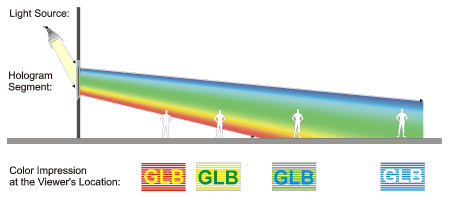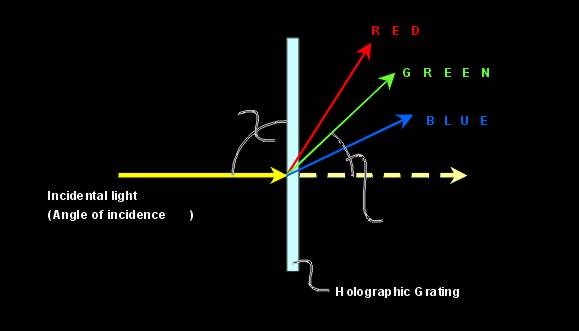Hi Greg,
thanks for your fast response. The background of my question is, that I
want to simulate the behavior of holographic optical elements (HOE). They
operate on the principle of diffraction (showing a similar effect as
prisms). HOE's offer two possibilities:
- Holographic Gratings bend the incident light from a fixed angle. Every
color is diffracted at a different angle. The rainbow colors will be
visible on the surfaces of the room.
- Holographic Displays bend the incident light from a fixed angle like
Gratings, the rainbow colors will be well visible on the hologram surface
from a wider viewing angle, but less visible on the surfaces of the room.
Do you have any good idea to realize this behavior in Radiance?
Best regards and a nice, hot day (today, we' ve got more than 98?F here in
Germany (outside, in the shade))
Frank


Frank Eggenstein wrote:
...
Do you have any good idea to realize this behavior in Radiance?
Best regards and a nice, hot day (today, we' ve got more than 98?F here in Germany (outside, in the shade))
Frank
HOEs could be modelled using Roland Schregle's photon-map implementation (http://www.ise.fhg.de/radiance/ and http://radiance-online.org/examples/pm-pab/\) if photon-map handled arbitrary user-defined cal files yet. Meanwhile, you could ask Roland about support for prism/prism2 materials, which would give an approximation of one HOE type (whose core advantage is of course to be much more flexible than prisms). Or model a diffractive structure with an approximative equivalent BRTF using dielectric and try to use this Hartmann constant (if photon-map supports it) to get the wavelength dependancy (ugly as sin to model HOE using diffraction). Not straight-forward, but rather cumbersome workarounds. Do you have a specific HOE to model or do you want to show the principle ?
If three color channels are not sufficient and the project is worth the extra work, run Radiance multiple times with different channels .
-Peter
PS: Radiance-online's mailinglist archiver doesn't handle email attachements well, so they won't show up in the archives.
···
--
pab-opto, Freiburg, Germany, www.pab-opto.de
Peter Apian-Bennewitz wrote:
HOEs could be modelled using Roland Schregle's photon-map implementation (http://www.ise.fhg.de/radiance/ and http://radiance-online.org/examples/pm-pab/\) if photon-map handled arbitrary user-defined cal files yet. Meanwhile, you could ask Roland about support for prism/prism2 materials, which would give an approximation of one HOE type (whose core advantage is of course to be much more flexible than prisms). Or model a diffractive structure with an approximative equivalent BRTF using dielectric and try to use this Hartmann constant (if photon-map supports it) to get the wavelength dependancy (ugly as sin to model HOE using diffraction).
Indeed, pmap does not currently support BRDFs based on data or function files, nor is prism supported. And while dielectric is supported, it does not use the Hartmann constant. Pmap was originally intended to support only simple, frequently used primitives. This isn't likely to change in the near future: lacking time, funding, and (above all) motivation, I will no longer be adding features to the photon map. I will make bugfixes to the existing code when necessary, but only for a limited time since the addon sees limited use anyway.
--Roland
···
--
END OF LINE. (MCP)

